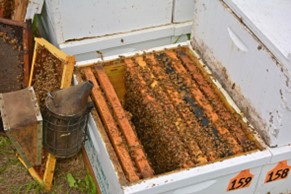Grassland conservation in the Dakotas generates millions of dollars in annual revenue for beekeepers while improving the abundance of sensitive bird species, according to a recently published study.

Scientists with the U.S. Geological Survey, University of North Dakota and North Dakota State University quantified the economic benefit of grasslands to beekeepers in North and South Dakota. They found that annual beekeeping revenue increased by $7,525 per 10 square kilometers in healthy grassland ecosystems. They also looked at the non-market value of grasslands to migratory birds and found that bird populations increased in grasslands by 2-7% per 10 square kilometers.
“Our study shows that grassland conservation is a win-win-win for the birds, the bees and the people of the Dakotas,” said Clint Otto, a USGS scientist and the study’s lead author. “These findings highlight the critical importance of grasslands to society and can help inform land-use policy.”
Commercial beekeeping in North and South Dakota is essential for honey production and agriculture across the country. Honey bees pollinate crops like almonds, fruits and vegetables, and flowers found in grasslands provide important pollen sources for bees. Many bird species, like the western meadowlark and grasshopper sparrow, also rely on grassland ecosystems in that region for food and habitat.
These grasslands are increasingly converted to row crops like corn and soybeans in the Dakotas. The study found that loss of grasslands is economically detrimental to the beekeeping industry:
- Since 2007, beekeepers lost $2-2.8 million annually where grasslands were converted to croplands in the Dakotas.
- Grassland area declined by 12.7% around Breeding Bird Survey routes in North and South Dakota from 2001-2016.
Understanding the market value of these ecosystems can shine light on the harder-to-calculate value of grassland biodiversity.
“Grasslands provide multiple ecosystem services to society,” Otto said. “It’s important for people who may never set foot on the prairie to understand the value of grassland in storing carbon, feeding livestock, improving soil health and water quality and providing habitat for bees and pollinators.”
The new study is published in the journal Ecological Economics. For more information on land-use change in the Prairie Pothole Region, please visit the USGS Northern Prairie Wildlife Research Center website.
We are here to share current happenings in the bee industry. Bee Culture gathers and shares articles published by outside sources. For more information about this specific article, please visit the original publish source: Grasslands Worth Millions to Beekeepers, Invaluable to Birds | U.S. Geological Survey (usgs.gov)






